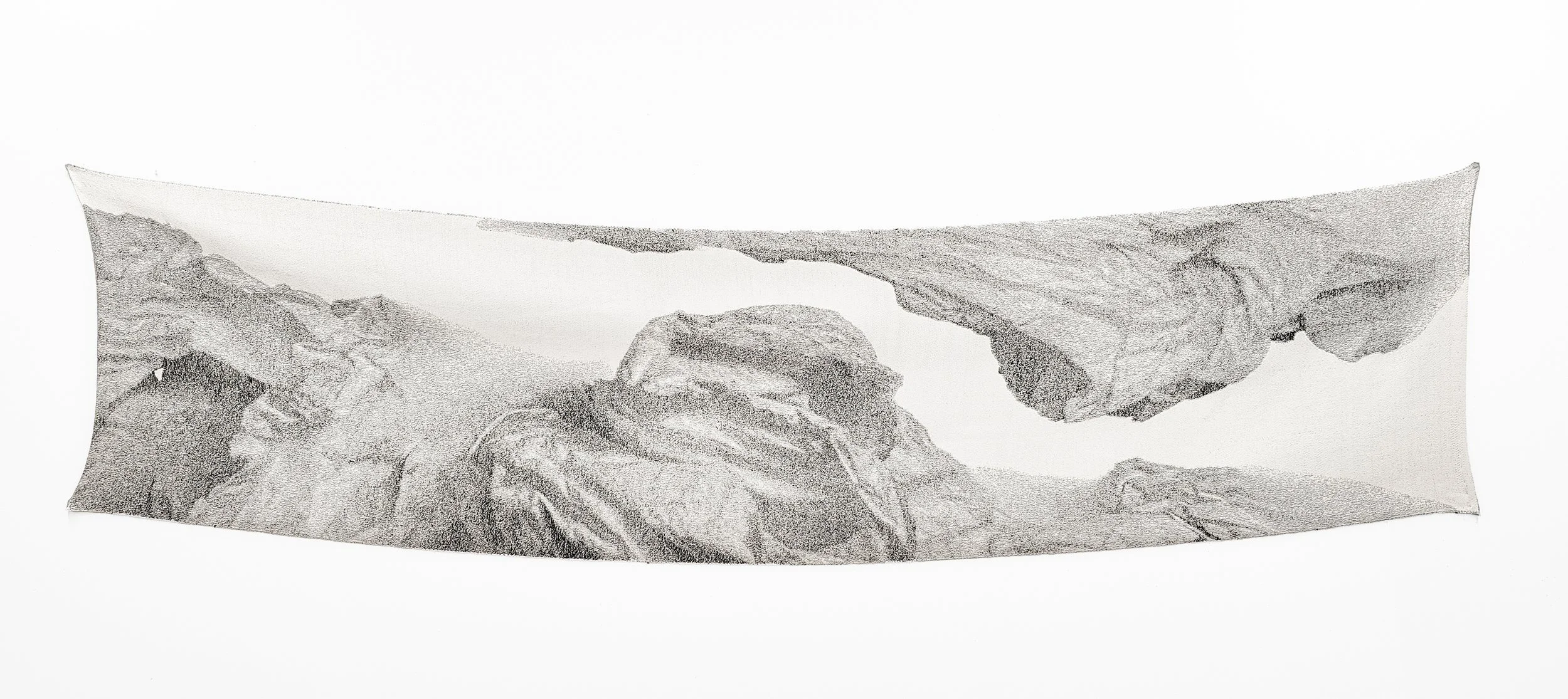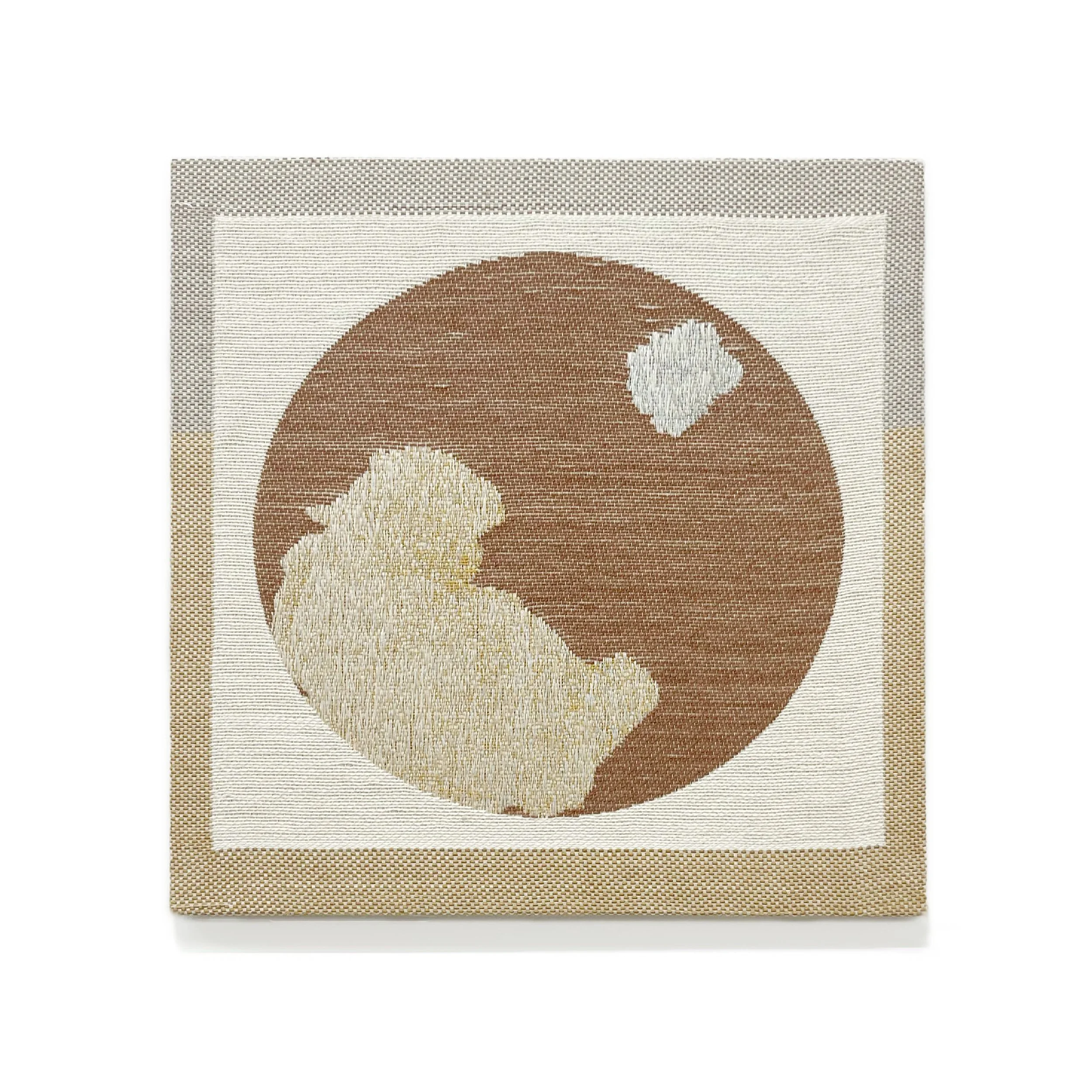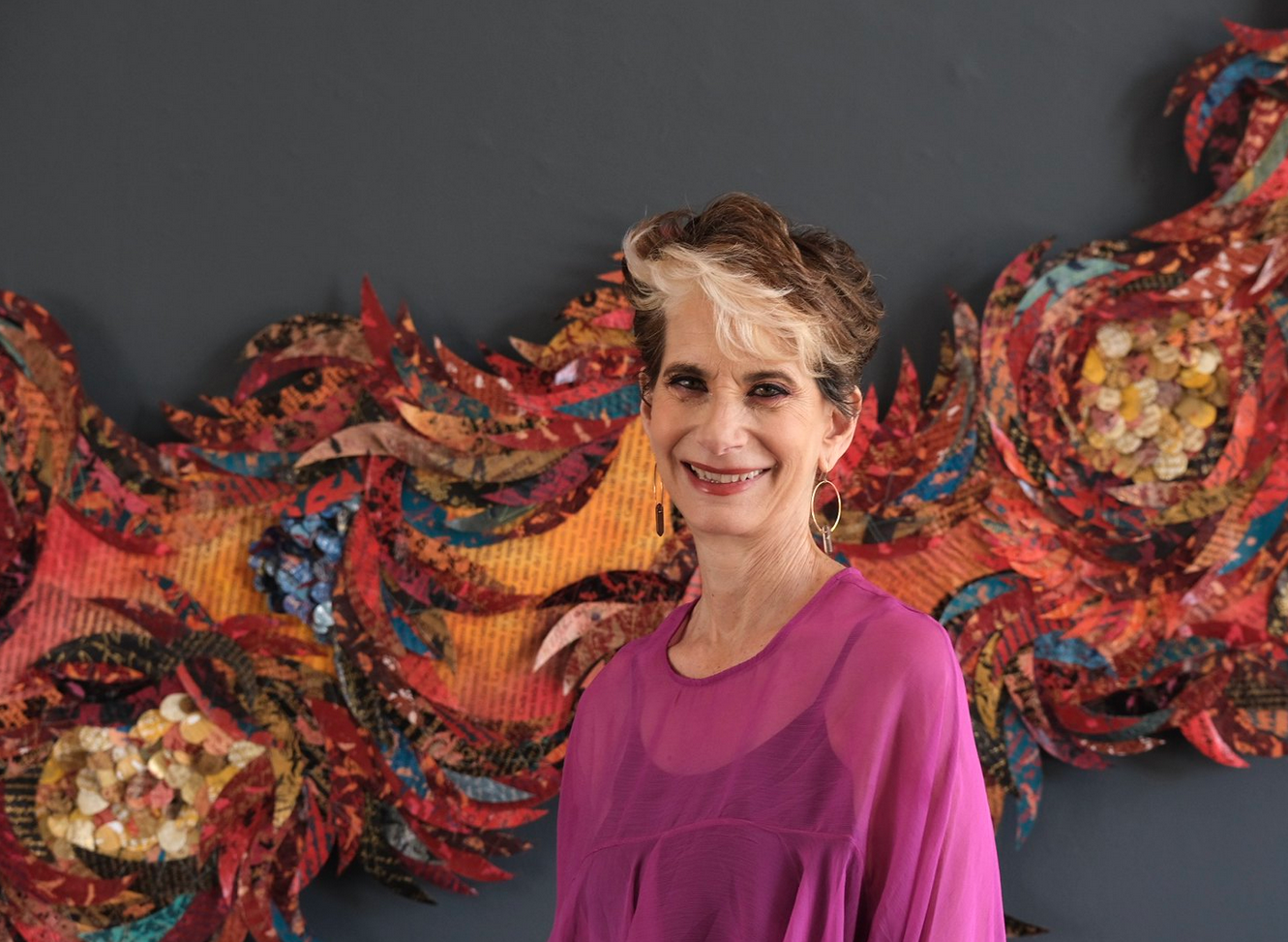10 Questions with Sitong Yin
Sitong Yin (b. Guangdong, China, 1999) is an artist and the granddaughter of a tailor. She is primarily a fiber artist and works around fiber and textiles, installations, and performance, currently based in Chicago, IL. Her work explores translations between materials, places, and cultures and the poetic and spiritual moments revealed in the gaps of translations. She obtained her Bachelor of Arts degree from the Fiber Art Department, China Academy of Art, in Hangzhou in 2020. She obtained her MFA in Fiber & Material Studies at the School of the Art Institute of Chicago in 2023. Yin has attended the Open Studio Residency at the Haystack Mountain School of Crafts (2022) in Deer Isle, ME, and the DWL AIR Residency at the Praxis Fiber Workshop (2023) in Cleveland, OH. She is a finalist of the Luminarts Cultural Foundation 2023 Visual Arts Fellowship.
Sitong Yin - Portrait
ARTIST STATEMENT
Sitong Yin is primarily a fiber artist. She works around fiber & textile, installations, and performance. Her work explores translations between materials, places, and cultures and the poetic and spiritual moments revealed in the gaps of translations.
Yin takes images of nature like landscapes and rocks and translates them into weavings, embroidery, paper, etc. By manipulating materials, craft technologies like jacquard weavings, digital embroidery, and papermaking and constantly evidencing the interplay between nature and materials, Yin is in search of the materiality of objects, of a state of existence, exists without being present, exists within in-betweenness. Imitation and use of natural materials and textures are the ways to build up a space for poetic wandering in her works, to examine a kind of nostalgia toward emptiness. This nostalgia responds to the loss of home and landscape in the context of environmental and cultural migration. Yin draws inspiration from ancient Chinese philosophies, art, and poetry for the methodologies of examining emptiness and meaninglessness and exploring how they are translated into and respond to contemporary context.
Yin’s work also responds to philosophical contemplation on the passage of space, time, and life & death. Her grandfather was a tailor; he died 30 days before she was born. She is currently the only textile worker left in her family. In between her grandfather’s life and hers, what and how is it translated?
LongScroll-1 長卷-壹, Digital Jacquard Weaving, 26.5x65 in each, 2022 © Sitong Yin
INTERVIEW
Let's start with your background. As you mention in your biography, you are the granddaughter of a tailor, which has a strong influence on your current practice. How do your family history and heritage inform your artistic practice, particularly in your exploration of textiles and fiber art?
I was born and raised in Shenzhen, China. By the time of my birth, my grandfather had already passed away for 30 days. At that time, no one in my family was involved in textile work. I learned how to knit from my grandmother when I was around five years old. Following that, my exploration of textiles continued, driven not by formal training but by spontaneous and natural curiosity, often by internet research or self-teaching. It wasn't until I was 17 years old that my dad casually mentioned to me that my grandfather was a tailor and that the entire family used to operate a tailor shop until the 1980s. Just recently, my mom told me that she and her sister used to make crochet lace tablecloths as a part-time job when they were children. It was in my senior year in college that I began to delve into my distant relationship with my grandfather and our family history surrounding textiles. Questions began to arise: What does it mean to inherit something from someone I've never met directly but whose blood flows within me? And what does it mean to employ the same approach that my family used to earn a livelihood in the context of contemporary art in my practice?
These are the fundamental questions that constantly occupy my thoughts. Eventually, they led me into a more philosophical and spiritual exploration of the translation of life and death, of the virtual and the real, and of different states of existence. I see immense potential in further themes to be explored from these questions about my heritage, such as the hidden labor history related to textiles in modern China.
Similar to the relationship between myself and my grandfather, the connection between my family history and my art practice is indirect yet fundamental.
Float#2浮#2, Digital Jacquard Weaving, 37x37 in, 2023 © Sitong Yin
What other experiences and training helped you become the artist you are today?
One of my earliest art experiences was practicing Chinese traditional ink painting. I recall developing a determination to become an artist shortly after beginning to paint at the age of 6. Initially, my lessons focused on flowers and birds, gradually progressing to landscape painting. What made my early painting lessons intriguing was that they never took place outdoors; instead, I faithfully imitated my teacher's strokes, never directly observing nature but rather imitating an imitation of it.
During this time, I lived in a small town named Sha Tou Kok, nestled between a mountain called Wu Tong (from which my name derives) and the sea. I spent much of my time playing in the mountain, interacting with the earth and the streams. I distinctly remember pondering why my paintings bore little resemblance to the actual mountain.
Through subsequent research into Chinese Art History, I came to understand that Chinese landscape painting prioritizes the expression of line movement, texture, and, more significantly, the conveyance of poetry and spiritual pursuit, delving into existential philosophy. Though I didn't grasp this concept as a child, my unique interactions with nature, both direct and indirect, profoundly influenced my current artistic practice.
Even today, I find myself instinctively drawn to natural materials and textures and their translation into art. I am intrigued by the process of translating real nature into depictions and imitations, pondering where and how poetry and spiritual sparks emerge from such translations and what can be conveyed or obscured. This exploration has been the primary focus of my research in recent years.
Your artistic journey began in Guangdong, China, but you are currently based in Chicago, USA. How has moving to the US influenced the themes and techniques present in your art?
Being away from my family, home country, and culture for the first time has provided me with an opportunity to step back and reflect on my personal history, heritage, and education—both artistic and general—and how they have shaped me as a person and an artist. I have begun to contemplate deeply the essence of being a Chinese contemporary artist and have observed differences in how I approach art compared to American artists around me.
In this journey of self-discovery, I have delved into the history of Chinese ink painting and have spent more time studying Chinese classical philosophy to gain a better understanding of my culture and traditions. However, amidst this exploration, I have also felt a strong sense of homesickness, missing not only my family but also the mountains and landscapes of southern China, which are nowhere to be found in the Midwest of the US. Recalling memories of playing in mountain streams, I have started to incorporate images of wrinkled Xuan paper, traditionally used for calligraphy practice, into my artwork as a way to cope with feelings of loss and distance. This reflection has also drawn my attention to my own name—Si, meaning "to miss," and Tong, referring to the Wu Tong mountain. Homesickness is not just a feeling but also a part of my identity; my name serves as an omen of sorts, embodying themes of distance, nostalgia, and destiny. As I continue to submerge deeper into my own nostalgic and poetic experiences through memories, I am also contemplating how my personal journey and experiences can be conveyed through my art within the contemporary context, where landscapes shift rapidly, and migration is constant.
On the aspect of techniques, I've had the opportunity to explore extensively jacquard weaving, which has been my main focus for the past two years. I've also been exposed to and experimented with other techniques, such as ceramics and papermaking, and expanded my ways of interacting with different natural materials.
LongScroll-2長卷-貳, Digital Jacquard Weaving, 26.5x140 in, 2022 © Sitong Yin
LongScroll-3長卷-弎, Digital Jacquard Weaving, 26.5x140 in, 2023 © Sitong Yin
As you mention in your statement, translation is a key theme in your work. Can you discuss the significance of this translation process and the poetic and spiritual moments it reveals?
Yes, as I mentioned above, the ponding upon translation started with my birth and my grandfather's passing. What always fascinates me is that there are 30 days between the two events, and it happens to be the time of a woman's physiological cycle and the time the moon takes to circle Earth once. There is something mystical within these 30 days. The interest in translation gradually extended into translations of visual languages, cultures, virtual and actual, and the act of translation itself. The act of translation lays in a state of in-betweenness, a state of neither nor, a zone of emerging, a zone of unknown, a zone of stirring and motion. For me, it is where the experience of art happens.
Despite defining yourself primarily as a fiber artist, you work with different mediums, such as textile pieces and installations, but also performance. What inspires you to employ such different mediums?
For me, the attraction to fiber materials is natural. I enjoy working slowly in a close relationship with materials. I always feel transported to another spiritual dimension while I am working with fiber and textiles. The immersion and repetition in making textile and fiber arts have always been able to calm me and are almost addictive to me. Also, the possibility of the conceptual exploration behind the materials is what keeps me working on the subject. Textile is one of the earliest crafts we mastered as homo sapiens and has a rich history related to gender, labor, modern computer science, and so on. What fascinates me most is what fiber offers as a structural model for modern philosophy and cultural research. For example, Deleuze and Guattari's "1440: The Smooth and The Striated" in A Thousand Plateaus and Tim Ingold's book Making. Fiber also has a significant influence on the development of Chinese characters. The possibility of Fiber arts is almost infinite and maybe that's why it is so tempting to me.
Installation is essential to art, for it activates the works within a certain space and its context. Whether they are wall pieces, sculptures, or fragment objects, the installation will be the final process of creation. Performance is another way for me to activate art. I tend to experiment with different craft technologies and always end up with a lot of fragments of samples and objects. What I enjoy and immerse myself in the process of creating, especially working with textiles, is the intimate tactual relation I have with materials. I try to convey this sensation of spiritual and poetic when these moments of intimacy happen to the audience by engaging them with the specimens and objects I made. Most of the time, these moments happen in motion. So, I will need to think of a way to install the works to make the space for the audience to be able to interact with my works or to interact with my works myself, which would be a performance.
Peek#1 窺#1, Digital Jacquard Weaving, 17x17 in, 2023 © Sitong Yin
Peek#4 窺#4, Digital Jacquard Weaving, 18x18 in, 2023© Sitong Yin
Peek#2 窺#2, Digital Jacquard Weaving, 17x17 in, 2023 © Sitong Yin
Peek#5 窺#5, Digital Jacquard Weaving, 18x18 in, 2023© Sitong Yin
Speaking of textile and fibre pieces, you use different techniques, such as jacquard weavings, digital embroidery, and papermaking, to primarily represent natural elements to express a sense of nostalgia. How do you give structure and cohesiveness to such a layered work?
I engage a lot of digital approaches in my works, which means a lot of the natural elements aren't directly included and seen. A lot of time, the natural elements have to go through a process of destruction and reconstruction, in other words, to be filtered in my works. I think I wasn't doing this intentionally at first. I grew up in a small town in Shenzhen, the frontier of new technologies and computer science in China at the time, and I was also able to experience nature in touch. It gives me both an attachment to nature and an interest in the digital process. My childhood experience also allowed me to see urbanization happening and the decrease of original forests along the way. I certainly live in an urban city, like most of us nowadays. Nature is either something we experience through documentaries and news or something we have as a tourist experience or mere memory. These experiences are filtered, indirect, sometimes commercialized,d and alienated. It makes me wonder, what does the nostalgia of nature represent? Is it the real nature we miss, or is it the virtual images of nature we miss? I think this is the reason for and where the cohesiveness comes from in my approach of involving different kinds of technologies to translate and manipulate the images of nature or nature materials.
You also draw inspiration from ancient Chinese philosophies, art, and poetry. How do you incorporate these influences into your work and how does it reflect on contemporary contexts?
As I mentioned above, I practiced Chinese ink painting as a kid. Also, ancient Chinese philosophies and poetry were a significant part of my general education growing up. So, rather than saying that I am incorporating these influences in my work, I would say that my art is born from their influence. As I grew up and immigrated to the US, I could see the trace of these influences more clearly and started to incorporate them more intensionally, especially with my study of textile technologies, for example, taking the idea of "Yin Yang" and void in Taoism in consideration in weaving structure, the "warp and weft" and how it forms up a plat, a surface, a space.
The question of what it means to be a Chinese contemporary fiber artist is essential to me. One of my approaches to answering that question is to look into Chinese art history and textile craft history. In an era where people are constantly migrating, and cultures are being colonized and alienated by capital, the importance of looking back at history for me is not to try to achieve a cultural renaissance or to consolidate a stable national identity. Rather, it provides a perspective on contemporary culture from outside the contemporary world.
Foursides四方, Digital Jacquard Weaving, 10.6x42.5 in, 10.6x38 in, 10.6x40 in, 10.6x35.8 in (from left to right), 2022 © Sitong Yin
As a finalist of the Luminarts Cultural Foundation 2023 Visual Arts Fellowship, how do you perceive the role of recognition and support from cultural foundations in fostering the growth of emerging artists like yourself?
They are definitely pivotal elements in nurturing the development of emerging artists like myself. These opportunities are valuable sources of motivation, particularly for recent graduates navigating the transition from art student to independent artist. Not only do they offer platforms for professional networking and engagement, but they also sometimes provide crucial financial assistance. I deeply appreciate the emphasis placed on supporting emerging artists such as myself by organizations like Luminarts.
You already have a varied and rich production, but is there anything else you would like to experiment with? Is there any new medium or technique you would like to implement?
Recently, I have been working with images of stones under the microscope and cross stitching. I am interested in the making of images in a slow, manual, pixelated way. And how it would change the reception of the images with lower resolution, and where is the fine boundary of representation and abstraction. I am also fascinated with how similar the micro-world is to the macro-world. I purchased a microscope a few years ago; I would like to play with more images of materials under the microscope, like branches, leaves, sand, etc.
For technique and medium, I am planning to do more sewing and stitching. And also allow myself to just do some more random material experiments. To play more, to have more possibility to engage with different materials.
In the sky飄, Digital Jacquard Weaving, 26x20 in, 2022 © Sitong Yin
And lastly, where do you see yourself and your work five years from now?
For now, I am trying to live one day at a time. It's getting harder and harder to be really present in life and be inspired by it, isn't it?
With all the issues in immigration and relocating, I honestly don't know what my life is going to look like in five years. All I hope for myself is to keep being healthy, keep thinking, making, and talking about arts, and keep being moved by life, engage more in the present.
Artist’s Talk
Al-Tiba9 Interviews is a promotional platform for artists to articulate their vision and engage them with our diverse readership through a published art dialogue. The artists are interviewed by Mohamed Benhadj, the founder & curator of Al-Tiba9, to highlight their artistic careers and introduce them to the international contemporary art scene across our vast network of museums, galleries, art professionals, art dealers, collectors, and art lovers across the globe.
























